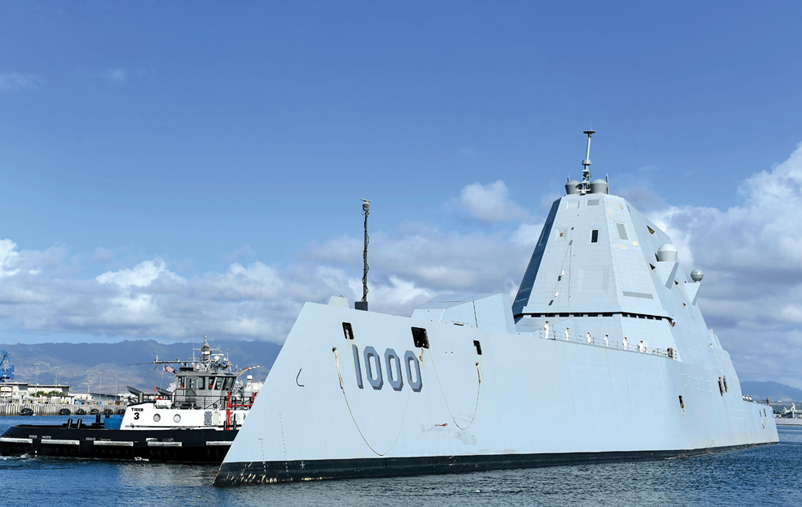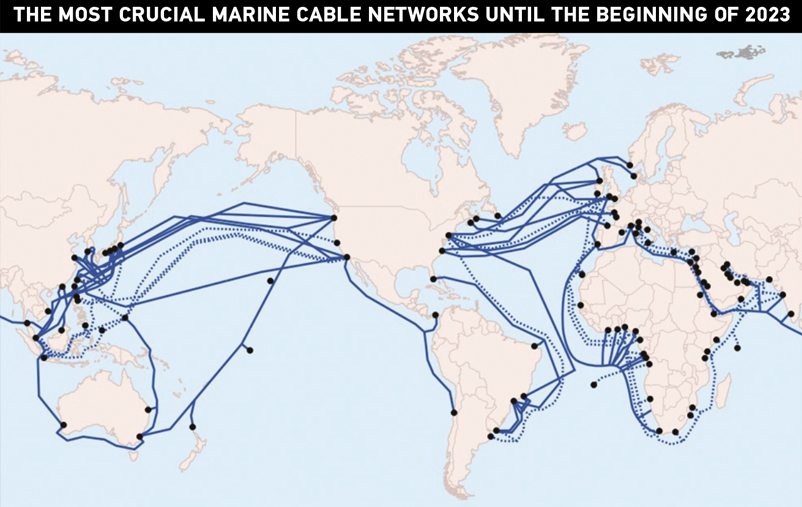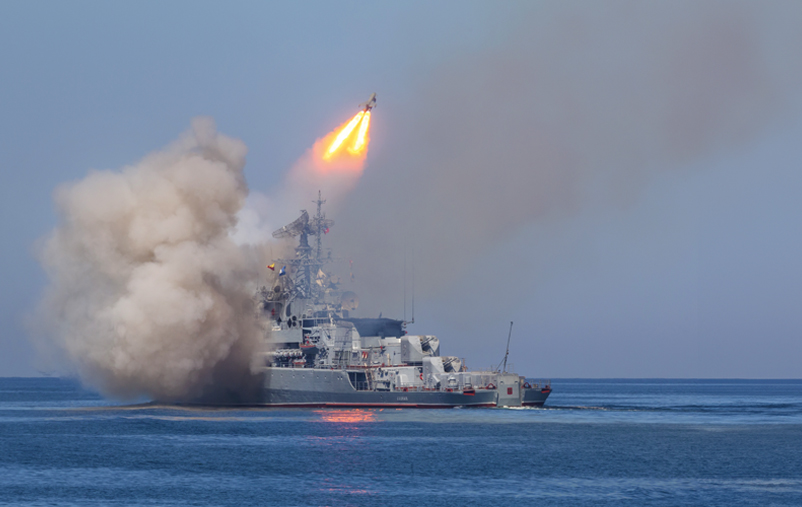Following the dissolution of the Soviet Union in 1991, the naval fleets of major powers gradually withdrew from the seas and oceans. This trend began with the Russian Navy, which rarely ventured far from its bases for over two decades. The United States also gradually reduced the size of its fleet. Awareness of the strategic importance of maritime military activity in the West only resurfaced in the early 2010s due to China’s increasing desire to control the South China Sea and maritime Silk Road routes. Many regions, including the Pacific, the Mediterranean, the Indian Ocean, and the Arctic, are witnessing continuous military naval rearmament.
Study Objectives
First: Key determinants of maritime armament trends in the next six years:
1- The chronic geopolitical environment stimulating intensified naval armament.
Given the geopolitical developments, maritime competition between regional and international powers has reached unprecedented levels. In regions like Asia and the Pacific, the competition has evolved from acquiring a larger share of maritime influence to a new phase involving armament and readiness.
The Chinese PLA Navy, reaching operational capabilities for its naval vessels, compelled the United States and its allies to increase investments to enhance their naval capabilities and adjust related security strategies. This is especially true after voices emerged suggesting the end of the era of American naval dominance, with the United States allegedly relinquishing the oceans to its adversaries. The concept of free seas can no longer be taken for granted.
China will seek further maritime control between 2024 and 2030, exemplified by the commissioning of the “Fujian” aircraft carrier into operational service by the end of 2025.
This new Chinese aircraft carrier possesses technology closely resembling American technology, such as the “electromagnetic catapult” system that facilitates the easy and rapid launch of large and modern aircraft like the Chinese J-15T fighter and other massive fuel carriers.
This addition will undoubtedly strengthen China’s maritime capabilities.
Comparison Between the US and Chinese Navies (The chart attached represents only the Chinese military navy, specifically the People’s Liberation Army Navy – PLAN, and not the Coast Guard fleet.)
The direct and indirect security repercussions of the Russian-Ukrainian War will continue to influence maritime armament in the coming years.
Additionally, new maritime confrontations and conflicts will arise worldwide. An example of this is the Indian Navy’s plan, at the end of last year, to deploy three missile-equipped destroyer ships in the Arabian Sea in response to attacks on commercial ships off the Indian coast to “maintain a deterrent presence.”

2- The persistence of the expansion and diversification of maritime control and warfare arenas
Over time, the military maritime domain has encompassed various new arenas, including air-sea and amphibious operations. Between 2024 and 2030, naval forces will strive to evolve more than ever, exploring new conflict areas such as cyberspace and cognitive conflict. They will also strengthen their presence in complex arenas, such as the deep sea, outer space, and the electromagnetic field.
The desire to control the depths of the seas is intensifying the underwater conflicts, particularly given their growing strategic importance for the global economy and in the field of communications.
This is highlighted by the fact that marine optical fibre cables are responsible for facilitating over 90% of digital data movement worldwide.
The world map of crucial marine cables underscores the significant tasks that the navy must increasingly undertake in the coming years to safeguard the depths where these cables lie. Disrupting these cables would undoubtedly lead to substantial strategic disruptions.
In addition to communication cables, the ocean floor has also been utilized for electrical cables (such as those connecting France and Ireland) and gas and oil pipelines (like Nord Stream under the Baltic Sea or the Turkish Stream beneath the Black Sea).
Moreover, submerged data centres add another dimension, requiring increased attention from naval forces in the coming days. Consequently, naval forces will seek to vertically enhance their operational capabilities from the sea surface to its depths.
For instance, the French Ministry of Armed Forces aims to control the ocean floor up to a depth of 6000 meters, following in the footsteps of the American and Chinese navies.
Concepts such as “Undersea Warfare” or the “Great Chinese Underwater Wall” highlight the strategic importance attached to the ocean floor. Addressing this “strategic ocean floor” perspective militarily will necessitate increased or enhanced naval capabilities, including:
1. Permanent or semi-permanent sensing systems, especially through underwater drones, to protect strategic areas.
2. Data collection and processing systems to handle the information gathered by sensing devices.
3. Intervention capabilities against any threat.
Therefore, given the inclination of influential countries such as China, to establish a strategic submarine system to restrict access to specific areas (A2/AD) and prevent foreign forces from accessing its territories (anti-access – A2), along with limiting their effectiveness in case of penetrating defence lines (AD – area denial), naval armament trends in the period 2024-2030 will depend on the development of new capabilities, as well as the priority given in this field.
Thus, naval forces will more than ever need mine warfare-related technologies.
On the other end of the geographic spectrum, the importance of air and outer space for naval forces will increase more than ever between 2024 and 2030. This is due to the easier access to these domains by countries that lacked such capabilities in the past.
Consequently, the emergence of private companies and new technologies may lead to a potential increase in conflicts in the air and space.
More conflicts may arise due to the denial of access to satellites and the increased use of jamming and cyber warfare. Given the importance of satellite capabilities in the maritime domain, naval forces find themselves caught in the paradox of increasing reliance on space to enhance operational capabilities while simultaneously increasing their ability to reduce dependence on space through various navigation means.
With the development of military digital technologies and military satellite capabilities such as the French Syracuse system, communication possibilities have become a reality. In this sense, the digitization of the battlefield takes on the form of a doctrinal revolution for naval forces, transforming the ship from a conceived “isolated unit” to a “communication platform”, this communication can be categorized as follows:
1. Horizontal: The ability to coordinate operations between various platforms, both manned and unmanned.
2. Vertical: The integration of communication systems or data processing from the air and space to the ocean floor.
This doctrinal revolution in naval communication is also a prerequisite for the integration of several systems related to the digital field, notably unmanned aerial, surface, or underwater vehicles. These vehicles must have permanent or at least relatively stable communication capabilities.
Therefore, the increasing digitization of the battle arena for major naval fleets worldwide will grow in the coming years, focusing on three interconnected and central issues as follows:
A. Cyber and electromagnetic protection for data processing and communication systems between platforms (the resilience issue).
B. Ensuring interoperability between systems and data links concerning allies and partners outside the scope of NATO, which has already taken this aspect into account significantly through working on tactical data links (the issue of interoperability).
C. Ensuring the compatibility between the development of digital naval systems onboard ships and the platforms’ ability to continue operating at a reasonable level in case of loss or disruption of access to all these systems or part of them (the issue of flexibility).

Secondly: Key Maritime Armament Trends in the Next 6 Years:
1- The Increasing Pace of Naval Forces’ “Missileization”
The Russian-Ukrainian War highlighted the growing importance of missiles in modern naval operations, whether against land targets launched from the sea or against naval or aerial targets.
Missiles have become a decisive element in naval warfare, despite their relatively recent use, which began during World War II. However, their pivotal role was only truly realized in 1967 when a Soviet-made Styx missile, launched by an Egyptian patrol boat, sank an Israeli destroyer at sea.
From that point on, missiles became the most widely used weapon in naval warfare, carrying both conventional and nuclear payloads. Currently, various platforms, including surface ships, aircraft, submarines, coastal defences, and unmanned aerial vehicles, are capable of utilizing them.
Key advantages of using missiles include:
1. Extended Range: Allowing the targeting of enemies from a distance without excessive risk to the launcher.
2. Variety of Types: Cruise, ballistic, supersonic, and hypersonic missiles cater to different environments—surface, maritime, or aerial.
3. Continuous Improvement: Ongoing enhancements in military capabilities, range, and some versions capable of transcontinental reach, allowing missiles to reach all targets.
The manufacturing and trade of missiles are expected to grow between 2021-2030 due to increased global tensions and the augmented production of new naval vessels.
Despite their diversity and secretive production by some countries, making it challenging to estimate their numbers accurately, studies suggest that the naval missile and launch system market could grow by around 6% annually between 2021-2030.
In this context, the expected growth and modernization of the U.S. Navy in the coming years are likely to boost the missile market. For example, in October 2023, Huntington Ingalls Industries (HII), a U.S. ship and submarine builder, secured a $154.8 million contract from the U.S. Navy to upgrade the USS Zumwalt DDG-1000 stealth destroyer. The upgrade includes equipping the warship with new electrical equipment, in addition to the hypersonic CPS missile system.
The planned construction of dozens of naval bases worldwide is also expected to generate significant demand for new missile systems. Many countries are rapidly expanding their arsenals to equip their growing fleets.
For instance, the Canadian Navy plans to replace its Iroquois and Halifax warships with 15 new ships by the end of the decade, armed with Tomahawk missiles, Sea Sparrow naval missiles, and the Sea Ceptor defence system.
India has expressed interest in acquiring BrahMos supersonic cruise missiles for its new warships. Moreover, major arms manufacturers are increasingly turning to missile production, and local regional players, notably Turkey, are entering the missile manufacturing market.
The next major development is achieving extreme speed and manoeuvrability in missiles, specifically, those capable of speeds greater than Mach 5 with the ability to manoeuvre at the end of the trajectory, making interception extremely challenging.
Few countries are developing such missiles and trying to overcome the complex technological obstacles that still hinder their deployment.
As of early 2023, Russia possessed hypersonic Zircon missiles and a scramjet-powered vehicle exceeding the speed of sound. China announced that it possesses DF21 and DF26 manoeuvrable ballistic missiles, along with hypersonic glide vehicles.
Furthermore, The United States has ongoing projects for hypersonic missiles, including a scramjet-powered glide vehicle intended to enable its latest destroyers and Virginia-class nuclear-powered attack submarines – expected to enter service around 2025- to strike ground targets.
Other nations, such as France, Japan, and India, are working on developing hypersonic missiles for their naval forces. For instance, the Indian Navy successfully conducted a test in March 2023, launching a supersonic BrahMos missile from a ship in the Arabian Sea.
Due to the technical complexities and high costs of hypersonic missiles in the maritime domain, it is unlikely, in the short term, that even advanced nations will be able to produce these weapons in large numbers.
However, such missiles will undoubtedly play a deterrent role in naval warfare between 2024 and 2030, and research is already underway to devise defences against these weapons.
Russian President Vladimir Putin announced late last year in 2023 that the multi-purpose nuclear submarines of the “Yasen-M” class possess formidable weapons, including long-range precision missiles capable of targeting both surface and coastal installations.
He explained that the two new nuclear submarines, named “Emperor Alexander III” and “Krasnoyarsk,” are unmatched missile carriers in their class and are set to enter service as part of the Russian naval force.
Moreover, he emphasized Russia’s commitment to enhancing its naval strength and expanding its maritime presence in all strategic regions of international waters.
International partnerships and collaboration in missile manufacturing are also on the rise. For instance, Norway and Germany have jointly declared their efforts to develop the new supersonic anti-ship missile, 3SM Tyrfing, to replace the Kongsberg NSM by 2035.
The evolving reality of anti-ship missile capabilities will compel defence policymakers and naval strategists to adapt to avoid defeat.
In this context, Albert Balazo from the University of New South Wales warns that we may be witnessing the beginning of a leap in the capabilities of land-based anti-ship missiles.

2- Breakthroughs in Weapons Production and Use Based on “New Physical Principles”
Traditional weapon systems rely on kinetic principles, where projectiles or missiles accelerate and hit the target. However, more modern weapons are based on “new physical principles”, enabling them to operate differently, targeting their objectives through electromagnetic pulses, lasers, particle beams, or charged-neutral particle beams. For instance, “plasma weapons” can destroy aerial targets without resorting to traditional missiles. Such weapons include electromagnetic weapons (using a strong and pulsed current, typically from coherent electromagnetic optical radiation found in certain types of lasers, or non-coherent optical radiation for targeting) and directed energy weapons. These military technologies do not involve conventional explosive projectiles but utilize highly focused energy such as electric, laser, or electromagnetic radiation to precisely target and destroy or disable objectives.
Directed energy weapons are categorized based on the type of energy they use, including sound and radiation, light, particles, plasma, and high-frequency “microwave” weapons.
The desired effects of such weapons on the target vary from destroying physical objects to confusing and redirecting or even disabling machinery or individuals. These weapons work by either directly delivering energy such as laser and electromagnetic weapons or by utilizing energy to launch inert projectiles such as electric cannons.
Although the development and experimentation of these weapons have been ongoing for several years, an increase in their pace of development and utilization is expected in the coming years, driven by the following features:
1. Broad and innovative range of use, from countering unmanned aerial vehicles to neutralizing satellites
2. Precision
3. Speed
4. A wide spectrum of effects to choose from based on the objective (disruption, paralysis, destruction, etc.)
5. Cost-effectiveness, given the absence of traditional ammunition
6. Limited collateral damage
7. Higher operational secrecy compared to conventional weapons
The U.S. Navy has been a pioneer in employing directed energy weapons. In 2014, its experimental laser weapon, “AN/SEQ-3,” with a power of 33 kilowatts on a maritime transport ship, successfully destroyed structural fixtures mounted on a small boat without causing damage to the boat itself.
Moreover, it managed to down an unmanned aerial vehicle launched from a ship. In August 2022, the U.S. Navy deployed its first operational high-energy laser weapon system known as “High Energy Laser with Integrated Optical-dazzler and Surveillance” (HELIOS) with a power of 60 kilowatts.
Lockheed Martin, the producer, emphasizes that HELIOS is not just a high-energy laser weapon; it is an integrated weapons system, including long-range intelligence, surveillance, reconnaissance (C-ISR) and anti-drone (ISR) capabilities. HELIOS integrates high-power laser technology and optical dazzler technology on the ship, changing the rules of the game by combining high-power laser technology and dazzler optical technology for swift, accurate and cost-effective targeting operations.
Another advantage of this weapon is its high upgradeability, enabling it to deal with future threats. Moreover, in 2024, the U.S. Navy aims to test the “High Energy Laser Counter Anti-Ship Cruise Missile Program” (HELCAP) with a power of 300 kilowatts.
For his part, Russian President Putin, speaking at the Eastern Economic Forum in Vladivostok, announced that Russia is working on manufacturing weapons based on new physical principles to ensure the security of any country in the near future.
Russia aims to innovate and develop weapons with unique physical properties using modern technologies and previously unused operational principles. This includes laser weapons, supersonic radiation, radio frequencies, and more.
3- The Development of More Unmanned Naval Vehicles and Underwater Drones
The Russian-Ukrainian War highlighted the increasing role of maritime drones in modern warfare, as armed forces seek more than ever to minimize human losses. Consequently, literature anticipates that maritime drones will be among the most crucial tools in future wars due to their distinct advantages.
While recent years have witnessed a surge in the development and use of unmanned aerial vehicles (UAVs), the naval armaments sector will likely experience a similar wave in the coming years concerning unmanned and autonomous maritime vehicles.
The need for these vehicles will grow, particularly in surveillance missions and even some offensive tasks. Many countries are already working on the development of more underwater drones, one of the prominent emerging trends in naval equipment development. This trend is driven by several factors, notably the reduction of risks and threats faced by crews and the more costly maritime assets. In the upcoming years, there will be an accelerated pace in the development of technological capabilities within major naval forces, leading to an increase in unmanned systems and platforms. These include unmanned aerial vehicles (UAVs), unmanned surface vehicles (USVs), and unmanned underwater vehicles (UUVs), all equipped with enhanced technological features, including advanced sensor systems.
Conclusion:
As always, flexibility and the ability to adapt, especially in the face of climate change effects, will be the key to naval armament in the coming years for any naval forces seeking to ensure their capability to confront the challenges of the next few decades.
This is particularly true in a geopolitical and military environment marked by uncertainty. Holding onto a singular perspective on the geopolitical environment was acceptable when preparing to face a predictable adversary, but such an approach is unsuitable in the context of the dynamic and uncertain environment that the naval forces will encounter more than ever.
Furthermore, integrating new technologies associated with artificial intelligence and leveraging them will be an integral part of addressing the challenges that naval forces will increasingly face in the coming years. These challenges include demographic (such as migration), technological, data/information and communication security, energy security, environmental and climate challenges, as well as challenges related to geopolitical and military power shifts.
Based on the above, we can assert that the three domains in which naval forces operate – “surface,” “air,” and “underwater” – will witness specific innovations and developments shaping the future of naval armament in the decades to come. In conclusion, a final determinant that will significantly impact naval armament in the coming years is the inevitability of cooperative combat and interoperability, as illustrated in the previous diagram.
» By: Professor Wael Saleh
(Expert at Trends Research & Advisory Center)














